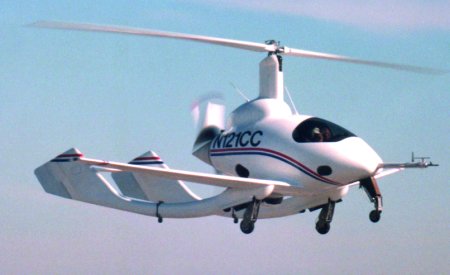Mechanical problems hit high-speed technology demonstrator after successful flight
Carter Aviation Technologies believes its innovative CarterCopter aircraft briefly, and unofficially, exceeded µ-1 (Mu-1) – the barrier to higher forward speeds in a rotorcraft – before suffering a crash later in the day that damaged the craft beyond repair.

The CarterCopter is a technology demonstrator for a slowed rotor/compound helicopter design, which developer Jay Carter has consistently pushed as a novel platform for achieving record rotorcraft speeds. Designed with the aim of overcoming the Mu-1 barrier (see box), the CarterCopter is a vertical take-off and landing aircraft that uses the rotor for take-off and landing, and a propeller and small fixed wing for high-speed flight which, theoretically, could reach up to 430kt (800km/h).
The company was flight testing the machine for a US Army contract on 17 June when the Mu-1 barrier is believed to have been passed. During the first flight of the day to test a newly developed speed controller for the rotor, test pilot Larry Neal “was decreasing rotor rpm in small increments when he neared µ-1”, says the company.
“With all systems stable, the decision was made to proceed above Mu-1. Initial data from the flight shows that the airspeed was 170mph [150kt] and the rotor was slowed to 107rpm, giving a µ value of 1.02. The flight time of higher than µ-1 was just 1.5s before Neal reduced the throttle to slow the aircraft, but the high-µ flight was accomplished without incident.”
Until this attempt, the vehicle had flown to a Mu of 0.87, a top speed of 150kt, an altitude of 10,000ft (3,000m) and a rotor speed reduced to 115rpm. Reaching the Mu-1-plus area “has been our goal since we first began flight testing in 1998”, says Carter. “To prove our technology, we needed to do something that no one else had ever done. We have had several setbacks, but no one on the team has even lost faith.”
The company’s joy was short-lived, however, because on the next flight, the CarterCopter crew reported mechanical problems and declared an emergency. “The aircraft was descending at an above-average speed and appeared to drop to the ground,” says the company. “The landing gear was down and absorbed enough of the impact of the aircraft to protect the pilot and co-pilot, who were uninjured.” The craft, which was the company’s only flight-test vehicle, will be “unrepairable for future flight testing”, it says.
It is not yet known what the plans are to resume testing with a replacement vehicle. The craft was being evaluated by the US Army as one of several technology candidates for its Air Maneuver Transport concept to support its Future Combat Systems. The crash landing is believed to be the ninth serious accident to befall the CarterCopter since 1998, all of which have been non-fatal.
Guy Norris / Los Angeles
Source: Flight International
















